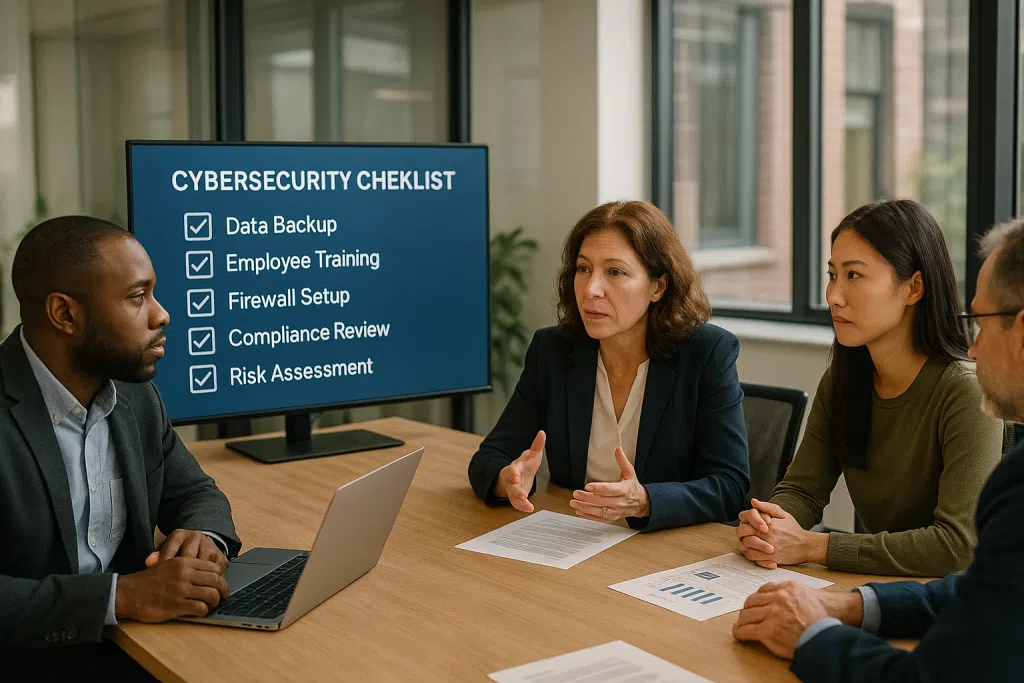Why Every SMB Needs a Cybersecurity Checklist: Understanding the Risks and Requirements
When it comes to protecting business assets, few priorities outrank cybersecurity, even for small and mid-sized companies. Data breaches, ransomware attacks, and regulatory penalties have become familiar threats in industries ranging from healthcare and finance to legal and pharmaceutical sectors. Despite this reality, many organizations rely on ad-hoc protections or outdated policies. The consequences? Costly interruptions, ruined reputations, or even legal liabilities. This is why an actionable cybersecurity checklist isn’t just prudent, it’s necessary.
Let’s face facts: Cyberattacks don’t only target multinational corporations. In recent studies, nearly half of data breaches have targeted small and mid-sized organizations. Healthcare practices, law firms, financial firms, and niche consultancies in New Jersey. Pennsylvania, and across the country, increasingly appear on criminals’ radar due to valuable client data and sometimes overstretched IT teams. As new compliance standards (like HIPAA, PCI-DSS, and evolving state and federal laws) grow stronger and penalties rise, business owners and IT leads can’t afford to “wait and see.”
A comprehensive cybersecurity checklist functions as both a defensive strategy and a blueprint for meeting cybersecurity compliance mandates. By systematically reviewing this checklist, SMBs improve their security posture, demonstrate due diligence to auditors, and cultivate client trust. This step-by-step approach empowers internal teams, or even co-managed IT partners, to avoid blind spots while efficiently leveraging resources.
The stakes are higher for regulated industries. Take, for example, a small healthcare practice in Princeton required to meet HIPAA security rule controls: failing to encrypt patient records, enforce access controls, or document employee training can trigger steep fines or worse, compromised patient confidentiality. Accountants and legal professionals must also maintain data integrity and privacy, especially now that clients expect robust security from all service providers.
Don’t wait for a cyber incident or a compliance audit to highlight gaps you could have prevented. Instead, let’s break down the practical, plain-English cybersecurity checklist that every small and mid-sized organization should adopt immediately. Before diving into the details, if you’d like to assess where your business stands or connect with IT security advisors, Book an initial discovery meeting with a local expert who understands your sector’s regulations and needs.
Building a Cybersecurity Foundation: Core Elements of an Effective IT Compliance Checklist
A successful cybersecurity program depends on clearly defined, actionable steps. A well-structured IT compliance checklist serves as the foundational guide for setting up and maintaining a secure digital environment. Each item on the checklist aligns with recognized cybersecurity best practices and regulatory mandates, creating a security net that leaves fewer gaps for threats to slip through.
- Asset Inventory and Classification: Start by cataloging every device, application, and data repository across your network. This includes servers, laptops, smartphones, cloud platforms, and even less obvious assets like printers or backup systems. By classifying assets according to risk, such as confidential client records or financial data, you’ll prioritize efforts where they matter most.
- User Access Controls and Privileges: One of the most frequent causes of security incidents is unrestricted access. Implement multi-factor authentication, require strong passwords, and use least-privilege principles so staff only access the information needed for their role. Regularly review user accounts for employees who have changed positions or left the company, closing gaps before they become vulnerabilities.
- Patch Management and Software Updates: Outdated systems present easy targets for malware and ransomware. Establish a formal policy to keep operating systems, business applications, and firmware current. Automated update tools or managed IT providers can remove much of the manual effort and ensure nothing gets overlooked.
- Data Backup and Recovery: Protecting data hinges on regular, secure backups. Employ a 3-2-1 backup method (three copies, two media types, one offsite or cloud-based) and test your recovery plan regularly. Don’t forget to encrypt those backups, especially for sensitive or regulated information.
- Firewall and Network Security: Firewalls serve as the first line of defense against unauthorized access. Pair them with intrusion detection and prevention systems, network segmentation, and secure wireless configurations. Encrypt traffic where possible and restrict public-facing services to what’s essential.
- Endpoint Security: Every device connected to your network is a potential entry point. Deploy up-to-date antivirus, anti-malware, and endpoint detection and response (EDR) solutions. Monitor for unusual activity, and make sure remote devices, like laptops used by attorneys or sales teams, adhere to the same standards as in-office equipment.
- Employee Security Awareness Training: Technology alone can’t thwart every attack, especially phishing or social engineering. Educate staff about common threats with recurring training sessions, simulated phishing emails, and clear reporting procedures for suspicious activity. Document participation and refreshers as part of your cybersecurity compliance program.
- Incident Response Plan: Even with solid defenses, incidents can occur. Draft a detailed response and recovery protocol: assign roles, document escalation procedures, and test your team’s readiness with tabletop exercises or simulated breaches. Having a practiced plan in place reduces panic and accelerates containment.
- Vendor and Third-Party Management: Any service provider or software your organization relies on, including cloud tools, billing vendors, or outsourced IT support, should be vetted for cybersecurity posture. Require security attestations (like SOC 2 or ISO 27001), include cybersecurity terms in contracts, and periodically audit providers for ongoing compliance.
- Documentation and Policy Review: Last, but not least, keep thorough records of all security policies, updates, training sessions, incident responses, and risk assessments. Regularly review and update these documents in line with evolving industry standards and legal requirements.
A checklist structured around these core principles forms a practical, repeatable workflow for internal teams or those working with a co-managed IT partner. It’s not a one-time exercise but a living set of habits embedded in business operations.
Strengthening Cybersecurity Compliance: Addressing Industry-Specific Mandates
General cybersecurity best practices form the backbone of defense, but regulated industries face additional scrutiny. Healthcare providers, financial advisors, law firms, and pharmaceutical businesses in the New Jersey area must all meet niche regulatory mandates. A one-size-fits-all approach just doesn’t cut it when compliance turns on the details.
Healthcare and HIPAA: Practices and clinics not only need encrypted electronic health records (EHRs) but must maintain audit logs, restrict access to protected health information (PHI), and deliver regular HIPAA training for every member of the organization. Risk management includes regular vulnerability scans and a documented breach notification policy, meeting both the spirit and letter of HIPAA’s Security and Privacy Rules.
Financial Sector and PCI-DSS/SOX: Processing credit cards, handling funds, or providing investment advice? PCI-DSS calls for robust encryption, secure card handling procedures, and incident logging. Sarbanes-Oxley (SOX) compliance mandates regular IT audits and data integrity protections, reflecting the heightened need for trustworthy financial records.
Legal Firms and Data Privacy Laws: Attorneys handle sensitive case files and client identities. Beyond state bar guidelines, law firms must now address state-specific privacy statutes and the growing demand from clients to verify digital security measures. Regular review of retention policies, secure file transfers, and multi-factor authentication should be included in the IT compliance checklist. Failing to meet these requirements can lead to malpractice claims or reputational damage, both costly to recover from.
Pharmaceuticals and FDA/21 CFR Part 11: The life sciences world faces complex documentation and electronic record-keeping demands. Strict digital signature protocols, audit trails, and robust backup plans are not just best practices; they’re regulatory requirements.
Recent updates, such as increased enforcement by the Department of Health and Human Services (HHS), or the adoption of the NIST Cybersecurity Framework by financial entities, highlight the importance of keeping your checklist current. According to the National Institute of Standards and Technology, periodic reviews and risk assessments are now standard expectations for passing audits.
Before investing resources in new platforms or workflows, business leaders should consider compliance as an ongoing lifecycle, not a box to tick during an annual review. By integrating both broad and industry-specific cybersecurity compliance measures, organizations decrease the risk of penalties and demonstrate to clients and regulators a proactive security culture.
Curious how your current operations stack up? For a tailored assessment or compliance audit, Book an initial discovery meeting with IT advisors who can interpret legal jargon and help close gaps unique to your industry.
Practical Cybersecurity Best Practices: Day-to-Day Safeguards for Modern SMBs
Applying cybersecurity best practices is just as critical as planning policies. In the real world, where employees juggle deadlines, clients, and emails, practical, accessible security steps ensure your checklist doesn’t gather dust.
Secure Password Policies and Multi-Factor Authentication (MFA):
Require passwords that combine uppercase, lowercase, numbers, and symbols, a bare minimum for accounts that touch client or financial data. But passwords alone are no longer enough. Multi-factor authentication, such as sending a code to a mobile device or using an authenticator app, stops many common attacks in their tracks.
Email Security and Phishing Protection:
Phishing remains a favorite tactic for attackers. Deploy layered email filtering tools, educate staff about suspicious lookalikes or unexpected requests, and emphasize a “no blame” culture when employees report suspected incidents. Many modern email solutions, like Microsoft 365 and Google Workspace, include advanced protections, but only if they’re configured correctly.
Mobile Device Management (MDM):
As remote work and bring-your-own-device policies become the norm, managing employee devices is essential. Tools that remotely enforce security settings, remotely wipe lost phones, or monitor apps add another layer of protection without stifling productivity.
Network Segmentation and Zero Trust Principles:
Avoid a “flat” network, where a breach in one area gives attackers access everywhere. Divide your infrastructure by department or sensitivity, and regularly review access permissions. Zero Trust means every device, user, and application must prove it belongs, every time it connects.
Patch Early, Patch Often:
Attackers prey on unpatched vulnerabilities. Set a strict timetable for reviewing, testing, and applying updates, not just for major systems, but also third-party applications, browser plugins, and firmware.
Incident and Breach Drills:
Simulate breaches via tabletop exercises. Run through potential scenarios: ransomware infection, compromised employee credentials, or an email scam targeting executives. This “muscle memory” reduces panic and speeds up real-world responses.
Physical Security Integration:
Digital security is only as strong as the doors, cabinets, and workspaces that hold sensitive assets. Consider badge access controls, visitor logs, camera systems, and policies for securely disposing of printed records.
A cybersecurity checklist is most effective when everyone is involved, from senior partners in a law firm to new hires handling onboarding documentation at a medical group. Repeat this process at least quarterly, and after major organizational changes, or when adopting new technology. For SMBs weighing the benefits of internal management versus co-managed IT, a clear, detailed IT compliance checklist helps clarify responsibilities and demonstrates due diligence to clients and auditors alike.
Implementing real-world best practices doesn’t have to overwhelm staff or drain resources. When in doubt, lean on IT professionals comfortable with the nuances of regulated industries and local support networks. For a guided review of these safeguards or to discuss bringing your security to the next level, Book an initial discovery meeting.
Auditing and Continuous Improvement: Turning Your Cybersecurity Checklist Into a Living Program
Maintaining cybersecurity is not a “set it and forget it” proposition. Auditing, the act of methodically reviewing your checklist for both technical and procedural gaps, transforms static policies into an evolving, mature defense program. Through audits, teams catch oversights early, adapt to new threats, and ensure documentation meets both internal and regulatory expectations.
Internal Self-Assessments:
Begin with honest, in-house reviews. Schedule quarterly (or at a minimum, annual) walkthroughs where IT and leadership systematically check off each item on the cybersecurity checklist. Document completion, identify gaps, and track updates, especially in response to business growth or technology changes.
External Assessments and Penetration Testing:
Bring in third-party consultants to perform deep dives, including vulnerability scans and “red teaming” exercises. These professionals approach your network with the mindset (and sometimes, the tools) of real-world adversaries, uncovering areas your internal teams may overlook. External validation helps meet compliance requirements and instills confidence in clients, insurers, and investors.
Metrics and Reporting:
Objective data fuels improvement. Track quantifiable metrics: number of phishing attempts detected, mean time to patch vulnerabilities, percentage of employees passing security awareness assessments, or frequency of backup testing. Dashboards and regular reports foster accountability and guide investment in training, software, or additional support.
Addressing Audit Findings:
Audits often expose uncomfortable truths: missing patches, underutilized security features, or gaps in communication protocols. Prioritize remediation based on risk severity. For regulated sectors like healthcare or financial services, audit reports must also be retained as evidence during formal compliance reviews.
Change Management and Documentation:
Audits only provide value if their insights lead to concrete changes. Document procedures for approving new vendors, rolling out software updates, and training new hires on evolving security measures. A living cybersecurity checklist is always a work in progress, nimble, continually updated, and deeply woven into business culture.
Notably, the Cybersecurity and Infrastructure Security Agency now emphasizes the adoption of continuous review cycles and measurable benchmarks within security frameworks for small and mid-sized businesses.
By embedding auditing into routine operations, organizations sustain stronger defenses, remain proactive about compliance, and can more easily communicate their security stance to partners, clients, and regulators.
Collaborating With Co-Managed IT: Leveraging Partnerships for Advanced Security and Compliance
For small and mid-sized businesses, managing cybersecurity in-house can feel daunting. Limited resources, the pace of new cyber risks, and the intricacies of compliance make it difficult to keep up. Enter co-managed IT, a model blending your internal expertise with specialized support from a trusted IT partner. This approach brings additional value to the cybersecurity checklist for several reasons.
Bridging In-House Gaps With Specialized Support:
Even businesses with dedicated IT staff often struggle with security incident response, complex compliance audits, or rolling out new security tools. A co-managed IT provider augments your capabilities, offering domain-specific expertise, round-the-clock monitoring, and tactical insight into emerging threats. With established relationships in regulated sectors (healthcare, finance, law), a provider can interpret legal updates and help update the IT compliance checklist accordingly.
Implementing Advanced Threat Protection and Automation:
Co-managed IT teams frequently deploy next-generation tools, such as endpoint detection and response (EDR), automated asset management, and cloud-based security solutions, scaling as your company grows. By collaborating on the cybersecurity checklist, they ensure no step gets skipped and that even advanced requirements (like secure mobile device management or compliance reporting) are met.
Cost-Efficiency and Resource Optimization:
The investment in external expertise can save money long-term by preventing costly breaches, failed audits, or downtime. It lets your leadership and internal IT focus on innovation, digital transformation, or core business goals, free from the anxiety of constantly monitoring threat feeds.
Real-World Co-Managed Success:
A Princeton-based accounting firm, facing repeated phishing attempts and new CMMC compliance mandates, worked with a regional co-managed IT partner. Within 60 days, they shifted from outdated checklists and ad-hoc backup routines to automated patching, formalized employee training, and real-time security posture dashboards. Audit readiness improved, and their clients benefited from the peace of mind delivered by both technology and documented protocols.
Continuous Improvement Loop:
A collaborative relationship means security protocols don’t stagnate. Co-managed teams hold quarterly reviews, update the cybersecurity checklist with lessons learned, and stay ahead of shifts in the legal landscape.
For SMBs juggling HIPAA, PCI-DSS, or even internal IT audits, co-managed IT partnerships turn the cybersecurity checklist from a compliance nice-to-have into a living, breathing advantage. Need insights on what co-managed security could look like for your specific industry? Book an initial discovery meeting to discuss collaborative security models and actionable checklists, tailored for your needs in New Jersey or beyond.
FAQs: Cybersecurity Checklist for SMBs
An effective cybersecurity checklist should cover asset inventories, password policies, regular software updates, endpoint protection, secure backups, employee training, incident response protocols, and vendor risk management. The specifics can differ based on industry, but these foundational areas provide robust defense against the most common threats.
Ideally, you should revisit your cybersecurity checklist quarterly, following any significant business or technology changes, and after any incident or breach. Annual reviews are the absolute minimum. Frequent reviews ensure emerging threats and evolving compliance regulations are addressed promptly.
Compliance adds specialized layers to the checklist, such as encryption of electronic patient data (for HIPAA), secure payment processing standards (for PCI-DSS), and detailed audit trails. Regular risk assessments, employee training specific to industry regulations, and documentation of all security practices become mandatory for regulated sectors.
Co-managed IT offers valuable advantages by supplementing in-house expertise with specialized support for compliance, alert monitoring, and incident response. Many SMBs find that external partners not only fill technical gaps but also provide the perspective and resources necessary to keep up with complex, changing cyber requirements.
Common pitfalls include neglecting to regularly update their cybersecurity checklist, giving too much user access, overlooking backup testing, failing to train staff on phishing scams, and not conducting periodic audits or vulnerability assessments. A static or incomplete cybersecurity program can leave organizations exposed to avoidable risks.





